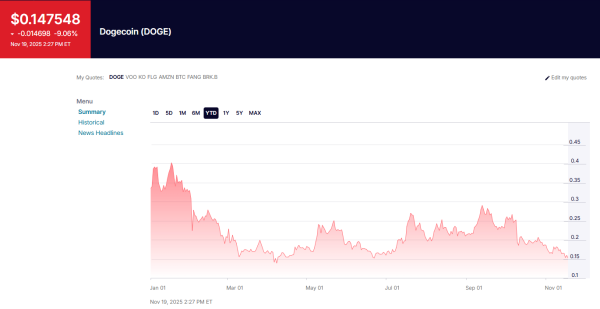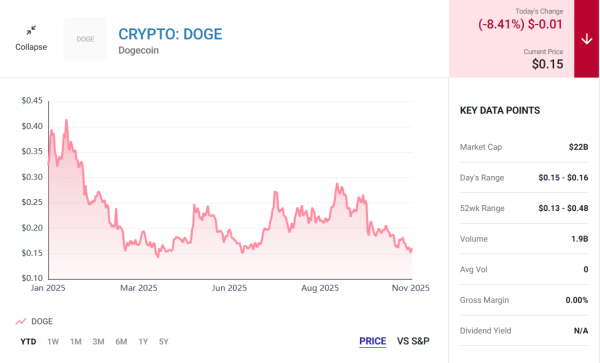Brokers from LFtrade have been analyzing Dogecoin’s severe 2025 correction, questioning whether the once-beloved meme token’s 51% decline presents a contrarian buying opportunity. Dogecoin has consistently stood out as a unique outlier in the cryptocurrency market.
It was born from humor, surged on hype, collapsed under its own weight, and then rallied again without any fundamental change in its real-world utility. But with its latest downturn, investors are now asking a critical question: Is this finally the moment to step in, or does the risk still far outweigh the potential reward?
To answer that, brokers are digging deeper into the broader history, the token’s economic structure, and its lack of real adoption. What they’re finding is a story that may surprise many casual traders.
A Meme Token Without a Foundation
Dogecoin began in 2013 when Billy Markus and Jackson Palmer created the token to poke fun at how seriously the crypto world was taking itself. What started as a joke quickly became a global phenomenon, ultimately hitting a record high of 0.73 dollars in 2021. At its peak, Dogecoin boasted an astounding 90 billion dollar market capitalization, making it one of the largest cryptocurrencies in the world.
Yet the rally was never driven by fundamentals. It was powered almost entirely by speculative frenzy and social-media enthusiasm, much of it led by Tesla’s CEO. When the hype cooled, Dogecoin’s value collapsed by more than 90% in just twelve months.
Even in 2024, when Dogecoin surged 252% thanks in part to renewed attention surrounding Tesla’s CEO’s appointment to the Department of Government Efficiency, the rally again lacked fundamental support. Once investors realized that no structural value was being added, the token quickly fell back into decline. By mid-2025, Dogecoin was down more than 52 % for the year.
The Harsh Reality: Dogecoin Still Has No Strong Use Case
One of the biggest issues brokers are pointing to is Dogecoin’s lack of real-world utility. Unlike XRP, which powers payment transfers in the Ripple ecosystem, or Ether, which fuels thousands of decentralized applications on Ethereum, Dogecoin has not carved out a meaningful role in the crypto economy.
In fact, only 2,126 businesses worldwide accept Dogecoin as payment. That number is minuscule in the global retail landscape. With so few places accepting it, consumers have very little incentive to hold or use Dogecoin regularly.
This lack of adoption means Dogecoin remains, at its core, a speculative asset. Every major rally has been the result of external hype rather than internal innovation or technological improvement. As brokers from the firm explain, speculative rallies can’t support long-term value without a real economic engine behind them.
Dogecoin’s Structural Supply Issue Is a Serious Red Flag
Beyond weak adoption, there is a much deeper structural issue: Dogecoin has no maximum supply cap.
Miners continue to create new Dogecoin indefinitely, and although there is an annual mining limit, the supply still grows forever. Currently, there are 151.8 billion DOGE tokens circulating, and that number will keep climbing.
This creates a perpetual dilution effect. Even if Dogecoin someday secures a strong use case, its ever-growing supply makes it extremely difficult for the price to maintain or grow in value. Brokers point out the core problem clearly: for the market capitalization to stay constant while supply doubles, Dogecoin’s price would theoretically need to fall by half.
By comparison, Bitcoin has a hard cap of 21 million coins, which fuels scarcity and strengthens long-term price stability. Dogecoin’s limitless supply works against investors rather than for them.
More Downside Might Be Ahead
Dogecoin bottomed at 0.05 dollars during its last major crash in 2022. Given the severity of its current 2025 downturn, brokers warn that a similar bottom is possible again. From current levels, that would represent a further 68 % decline.
Investor sentiment has also weakened substantially. The hype cycle surrounding Tesla’s CEO and the DOGE acronym may have fueled last year’s surge, but it was short-lived once again. Without a fundamental catalyst, enthusiasm is fading, and price pressure is increasing.
Is the Dip a Buying Opportunity?
After reviewing the structural, economic, and behavioral factors surrounding Dogecoin, many financial analysts have reached a clear conclusion: this year’s 51 % dip does not look like a buying opportunity.
The token still lacks a strong use case, its supply structure works against price appreciation, and its rallies consistently collapse when hype fades. While Dogecoin may continue experiencing short bursts of speculative excitement, its long-term outlook remains weak until meaningful utility is developed.
For investors seeking durable growth and stability, brokers argue that Dogecoin simply doesn’t offer the foundation needed to justify long-term confidence.











